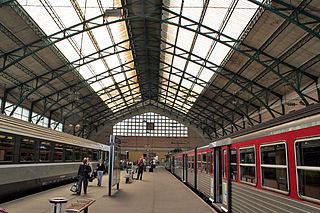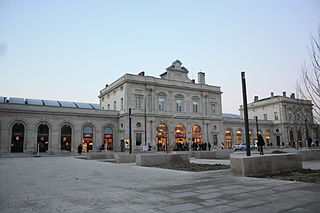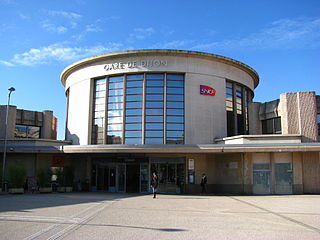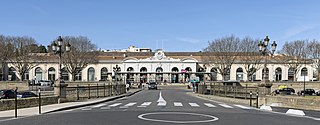
The Gare de Lyon, officially Paris Gare de Lyon, is one of the seven large mainline railway stations in Paris, France. It handles about 148.1 million passengers annually according to the estimates of the SNCF in 2018, with SNCF railways and the RER D accounting for around 110 million and the RER A accounting for 38 million, making it the second-busiest station of France after the Gare du Nord and one of the busiest in Europe.

Gare d'Austerlitz, officially Paris Austerlitz, is one of the seven large Paris railway terminal stations. The station is located on the left bank of the Seine in the southeastern part of the city, in the 13th arrondissement. It is the start of the Paris–Bordeaux railway; the line to Toulouse is connected to this line. In 1997, the Ministry of Culture designated the Gare d'Austerlitz a historical monument; it became the fifth large railway station in Paris to receive such a label, as currently only Montparnasse has not been attributed it.

The Gare de l'Est, officially Paris Est, is one of the seven large mainline railway station termini in Paris, France. It is located in the 10th arrondissement, not far southeast from the Gare du Nord, facing the Boulevard de Strasbourg, part of the north–south axis of Paris created by Georges-Eugène Haussmann.

Le Havre station is the main railway station located in Le Havre, Seine-Maritime, France. The station was opened on 22 March 1847 and is located on the Paris–Le Havre railway. The train services are operated by SNCF.

Amiens station is the main railway station for the Northern French city of Amiens.

Brest station is the railway station serving Brest, France. It is the western terminus of the Paris–Brest railway. The new station, built above the town's harbour in 1932 on the site of its 1865 predecessor, includes a tall clock tower and a semi circle passenger hall. The current building of 1932, by the CF de l'Etat, replaces the older building built in 1865 by the CF de l'Ouest.

Nice-Ville station, also known as Nice-Thiers station, is the main railway station of Nice, France. It is situated on the Marseille–Ventimiglia railway and constitutes the southwestern terminus of the Nice–Breil-sur-Roya railway. Nice-Ville is served by TER, Intercités and TGV services, as well as the Gare Thiers stop on Line 1 of the Nice tramway.

Luxembourg railway station is the main railway station serving Luxembourg City, in southern Luxembourg. It is operated by Chemins de Fer Luxembourgeois, the state-owned railway company. 80,000 passengers use this station every day.

Reims station is the main railway station in the city of Reims, Marne department, northern France.

Champagne-Ardenne TGV station is a railway station located in Bezannes, France that opened in 2007 along with the first phase of the LGV Est, a high-speed rail line running from Paris to Strasbourg. It is situated about five kilometres south of Reims; the station is a stop for TGV, Ouigo and TER Grand Est services.

Strasbourg-Ville station is the main railway station in the city of Strasbourg, Bas-Rhin, France. It is the eastern terminus of the Paris-Est–Strasbourg-Ville railway. The current core building, an example of historicist architecture of the Wilhelminian period, replaced a previous station inaugurated in 1852, later turned into a covered market and ultimately demolished.
With nearly 24 million passengers in 2023, Strasbourg-Ville is one of the busiest railway stations in France outside of the Île-de-France.

The gare d'Avignon-Centre is a railway station serving the city of Avignon, in Vaucluse, France. It is on the Paris–Marseille railway.

Lorraine TGV station is a railway station located in Louvigny, France, on the LGV Est, a high-speed rail line running from Paris to Strasbourg. Opened in 2007 as part of the first phase of the new line, it is situated near Metz–Nancy–Lorraine Airport, between the cities of Metz and Nancy. As the two other new LGV Est stations it is served by TGV inOui and Ouigo services.

The Gare de Mulhouse-Ville, also known as Gare Centrale, is the main railway station in the city of Mulhouse, Haut-Rhin, France. It is the eastern terminus of the Paris-Est–Mulhouse-Ville railway.

Nancy-Ville station is the main railway station serving the city Nancy, Meurthe-et-Moselle department, northeastern France. It is situated on the Paris–Strasbourg railway.

Dijon-Ville station, sometimes simply Dijon, is a railway station located in Dijon, Côte-d'Or, eastern France. The station was opened in 1849. It is located at the junction of Paris–Marseille, Dijon–Saint-Amour, Dijon–Is-sur-Tille, and Dijon-Vallorbe lines. The train services are operated by SNCF and Lyria.

Charleville-Mézières station is a French railway station serving the town Charleville-Mézières, Ardennes department, northeastern France. TGV trains run to Paris as well as regular local services to Reims. Prior to the opening of the LGV Est between Paris and Strasbourg in 2007, two trains a day used to run in each direction between Gare de Lille Flandres and the Gare de Metz-Ville.

Carcassonne is a railway station in Carcassonne, Occitanie, France, on the Bordeaux–Sète and Carcassonne–Rivesaltes lines. The station is served by TGV, Intercités and TER services operated by SNCF.

The Metz–Luxembourg railway is a 72-kilometre-long (45 mi) French/Luxembourgish railway line, that connects the French Lorraine region to Luxembourg. The railway was opened between 1854 and 1859. It is an important international railway connection. The part in Luxembourg is designated as CFL Line 90.

Saverne station is a French railway station located on the Noisy-le-Sec–Strasbourg railway. It is located within the commune of Saverne, in departement Bas-Rhin, in northeastern France.




































